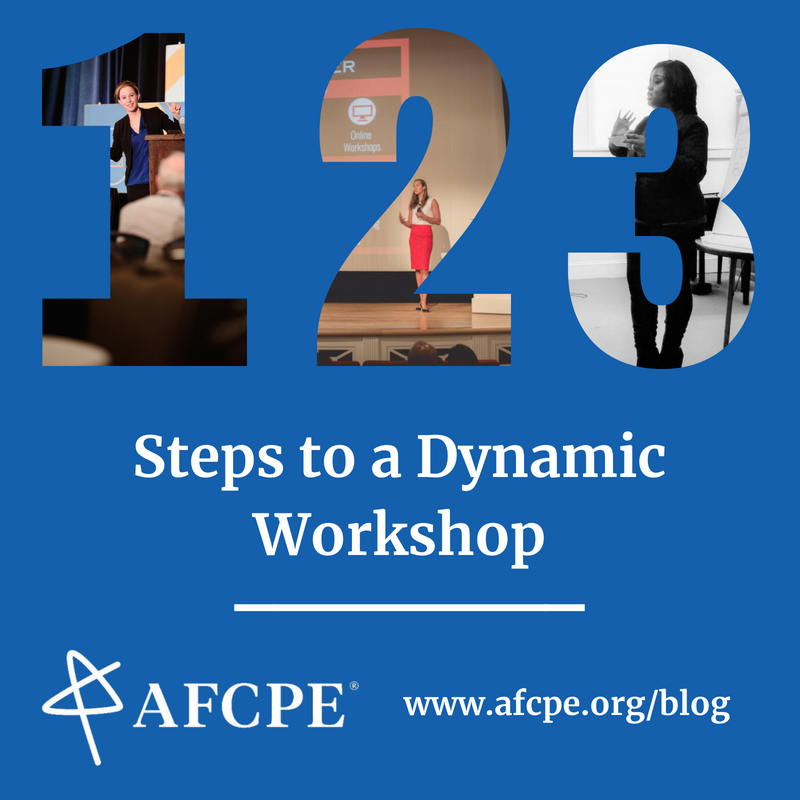When it comes to presenters who read their slides, audiences have reached their limit. The relentless dependence on bullet points and text-dense slides do more to bore than to entertain or inspire. In my last blog post, Presenter to Bullet Point: “You’re Fired!, I concluded with a promise to provide you with a simple process “to build a presentation from inspiration to delivery.” Delivering on that promise, below are 3 concise steps (1-2-3) to help you build a dynamic workshop.
Step 1: What is the ONE message of your presentation?
What is the one point that you want your audience to know? Whether you are persuading, instructing, or comparing and contrasting, you must be able to boil down your message to one central theme. This theme should be the glue that cements each of the 1-2-3 steps into one cohesive presentation.
For example, if you are delivering a workshop on retirement planning, is your central theme that planning today will ensure that your audience can maintain a decent lifestyle in the future? Or perhaps you want to emphasize that small savings today can have big impacts on quality of life decades down the road. There might be an unlimited number of messages a broad subject (such as retirement planning) could evoke, but you must create and stick with one central message throughout your workshop and drive that point home repeatedly.
Step 2: What are TWO (or three) key take-aways that support the main point?
These are two facts that your audience may easily recall and will help to etch the workshop into longer-term memory. If effective fact nuggets are employed, your audience will ideally share them with others, thereby expanding the impact of your presentation.
Continuing the retirement planning seminar example above: a key take-away could reflect that saving X dollars today = Y dollars in 30 years. Whatever the points, make them simple, easy to digest, and easy to repeat.
Step 3: Compose the workshop in THREE parts: Introduction, supporting body, conclusion.
Think back to the high school classroom, when the basic parts of the composition were drilled into your permanent memory: beginning, middle, and end. An essay was that simple, and every one of your workshops could—and should—be that uncomplicated too.
- Your presentation should begin with a very strong question, statement, or even an image that immediatelycreates interest in your audience. The introduction should help to answer the “What’s in it for me?” question that each member of the class is asking, albeit in their heads. The introduction lets you frame that question any way you want, as long as you make it interesting.
- Once you’ve figured an effective “hook” to lure your audience in, compose the body of your presentation. Of course, the body will include the key take-aways mentioned in Step 2, as well as any other supporting arguments, data, experiences, or anecdotes that further your central theme and reinforce the questions or statements made in the introduction.
- The conclusion gives you, the presenter, one final chance to make your case to the audience and, therefore, should never be considered a place to wind down the workshop. On the contrary, use the conclusion to energize your audience and, once more, remind them why your presentation was so important—to them.
You will note that, in the discussion of the 1-2-3 Steps, there was no mention of creating slides, devising an animation scheme, or arranging lists of bullet points. In my personal experience, the above process will help you stick to what’s important (content) and avoids the common pitfall of creating a workshop by creating slides. Remember: your slide deck is a communication tool that should heighten the impact of the content, not hinder it. Therefore, if you begin with the 1-2-3 Steps, you should find that any slides you choose to create will almost create themselves. Almost.
While I have learned much of this approach from my own trial and error, I have also enjoyed the benefit of exceptional peer feedback. Further, I have improved by observing many other public speakers, and have learned widely from numerous publications. Some of my favorite books on public speaking are listed below:
- Presentation Secrets of Steve Jobs by Carmine Gallo
- Presentation S.O.S. by Mark Wiskup
- Life is a Series of Presentations by Tony Jeary
- Presentation Advantage by Kory Kogon and Breck England
- TED Talks: The Official TED Guide to Public Speaking by Chris Anderson
I encourage you to use the 1-2-3 technique to create your next presentation. In my experience, its simplicity makes the composition of your workshop just as satisfying as the delivery itself.
Guest Contributor: David Kershberg, AFC®

Leave a Reply